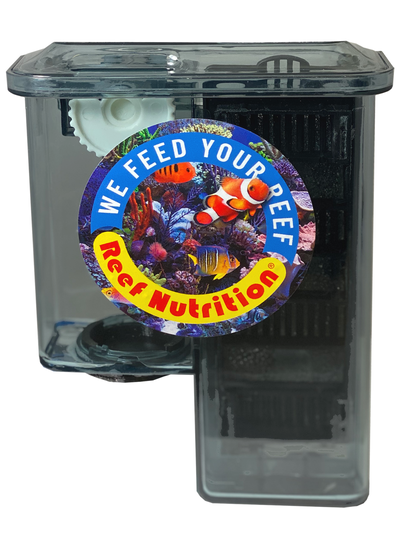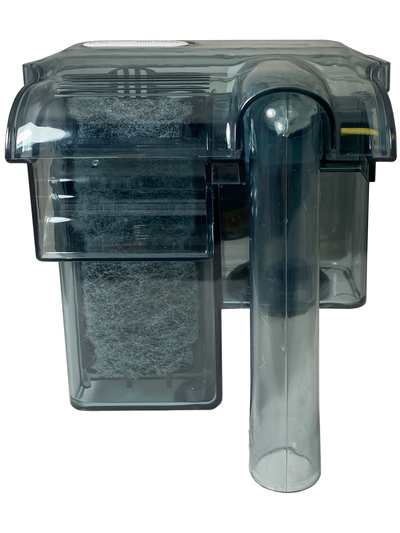


Roti-Clean™ Filter
Our Breeder's Choice Roti-Clean Filter is designed to make benchtop-scale medium density culturing of zooplankton simple and reliable. Growing rotifers for Clownfish Breeding has never been easier!
Product Description
FAQ and Features
Does the filter pump harm the rotifers?
It does not. The rotifers are pumped through the filter without any harm to their bodies. The pump does not reduce their ability to feed and reproduce.
Does the filter floss remove the rotifers?
No. The rotifers pass through the material. If the filter floss insert is fully clogged, the water and rotifers simply flow around it.
Features:
- Commercial performance at bench top scale
- Easy to use – easy maintenance
- Medium density cultures
- Stable cultures
- Optimized oxygenation
- Optimized circulation
- Optimized waste control
- Simple, durable design
- Easily transported
Setup and Maintenance
Assemble filter
|
Attach the small pump to the independent, extension tube. The pump has been modified to maximize productivity. |
 |
|
Insert the extension tube into the filter intake tube. |
 |
|
The extension tube should be as low as possible in the culture. |
|
|
If detached from the filter, attach the filter leveling device to the bottom of the filter housing. |
 |
- Attach the graduated sticker to your bucket.
- Hang the filter on the bucket.
- Fill bucket with 16 liters (4.2 gallons) of saltwater.
- Plug in the pump.
- Add your rotifers if you are doing this for the first time.
- For a more dense rotifer culture, we recommend adding aeration. An open-ended rigid airline connected to a small air pump is acceptable. Make sure the air is not directly under the filter intake.
Filter Housing Maintenance (once a week)
- Pour the water from the filter into the bucket.
- Spray the unit with freshwater to blast out organic debris.
- You can also submerge the entire filter with pump and all the loose parts in a low concentration of bleach and then rinse thoroughly.
- Rinse the pump and all other fittings before reassembly.
Bucket maintenance (once a day)
Harvest Culture & Water Change
- Once culture reaches desired density, harvest 20% each day.
Clean Floss Insert
- Remove the filter insert and let free water drip into bucket
- Rinse the filter insert at the sink.
Brush Bucket Surfaces
- Using a common toilet brush or similar non-abrasive scrubbing tool, clean all interior surfaces of the bucket to remove adhering detritus so it can be trapped and removed by the floss.
Feed Rotifer Culture
- Add dose of algae (RGcomplete or other Instant Algae food) to the filter housing so that it is evenly dispersed throughout the culture.
- It is ideal to feed your rotifers at least twice a day.
- A typical dose of RGcomplete is 6 mls per day. It is best to break this amount up into at least 2 feedings. For example, feeding 3 mls in the AM and 3 mls in the PM.
Reinsert Filter Floss
- After cleaning, reinsert the filter floss. Leave the insert in until you need to clean it. The insert will scavenge waste in between harvesting and cleaning. You do not need to remove the insert unless you are cleaning it.
Replace Harvested Water
- Refill bucket to normal operating level with new, clean saltwater. Do not use water from your broodstock system or reef tank.
NOTE: After a newly-started culture has been growing for a while, some products of rotifer metabolism accumulate in the water and result in foam formation. You will also see the water gradually turn brownish, for the same reason. This brown coloration makes is harder to see the green tint from the feed in the water, but you can use the appearance of the foam to judge when the feed is depleted. RGComplete actually has anti-foam properties, and you will see that when you add feed the foam dissipates. Accumulation of foam doesn’t necessarily mean you need to feed. If you are producing enough rotifers for your needs with a particular feed rate, you don’t need to increase the feed. But the foam does tell you that if you feed at that point, you are not in danger of overfeeding.
Harvesting and Counting
Harvesting the Rotifer Culture
- It is best to harvest rotifers every day.
- Approximately 20% is a good daily harvest rate.
- If one day you need more rotifers, it is OK to harvest more heavily. To increase the number of rotifers harvested every day, increase the feed rate but keep a consistent harvest rate. For fewer rotifers just reduce the feed rate.
- To harvest rotifers, remove the appropriate volume of culture. The rotifers can be concentrated on a screen and collected. Rinse the rotifers into a container with saltwater before feeding out. Discard the harvested water.
- Replenish the rotifer culture with new saltwater.
Counting Rotifers
- Important: Stir culture first to ensure a representative sample
- Pipet a sample (typically 10 mL) into a vial. To immobilize the rotifers for counting, add 5 drops of vinegar and mix.
- Important: Stir sample so it is well-mixed and then quickly — before rotifers have time to settle out — use a pipet to transfer a known volume to a counting slide.
- Count the rotifers in that volume and calculate the number per mL or L.
- Your count should include at least 100 rotifers to be statistically reliable. If it is lower, count additional volumes.
- The most accurate counts are made with a Sedgewick-Rafter type slide that has a grid of 50 x 20 = 1,000 squares. You can count the rotifers in 100 squares and multiply by 10 to get the number of rotifers/ml. If the number is below 100, count more squares; if you count 200 squares, multiply by 5.



